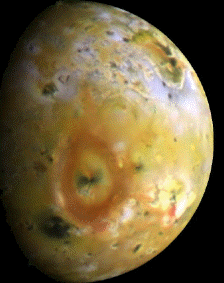This is an image of the surface of Io,
looking down on a volcano and the lava plain surrounding it.
Click on image for full size
NASA
Surface of Io
The surface of Io is completely volcanic, with lava flows of
sulfur from the
interior, as shown in this image. White patches in the image are areas of frost made of sulfur dioxide instead of water.
The heat for this volcanism comes from the special position of Io relative to Jupiter and the other moons. Io is a small moon, very close to Jupiter, and well inside the other 3 main moons. Io feels the gravitational pull first of Jupiter, then of the outside moons when they sweep by. The alternating pull of gravity has a push-me, pull-me effect on Io, which deforms the moon, and warms it just the way a coat hanger warms when you bend it first one way, then the other way.
Due to this warming, Io has many volcanoes.
You might also be interested in:
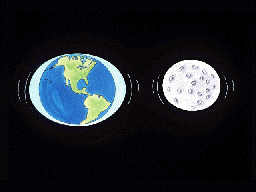
The force of gravity caused by an object gets weaker as you move farther away from that object. In this picture, the Earth is pulling on the Moon, and the Moon is pulling on the Earth. The Moon pulls more
...more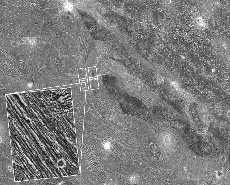
There has been no icy volcanism on Ganymede, nor continental drift, but it does seem that there have been movements of the surface. Examination of the surface of Ganymede reveals many kinds of faulting.
...more
Amalthea was discovered by E Barnard in 1872. Of the 17 moons it is the 3rd closest to Jupiter, with a standoff distance of 181,300 km. Amalthea is about the size of a county or small state, and is just
...more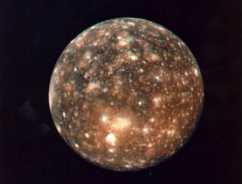
Callisto was first discovered by Galileo in 1610, making it one of the Galilean Satellites. Of the 60 moons it is the 8th closest to Jupiter, with a standoff distance of 1,070,000 km. It is the 2nd largest
...more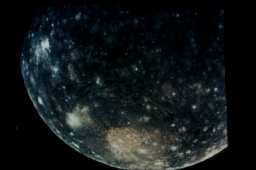
The insides of most of the moons and planets separated while they were forming out of the primitive solar nebula. Measurements by the Galileo spacecraft have been shown that Callisto is the same inside
...more
Many examples of the differing types of surface are shown in this image. In the foreground is a huge impact crater, which extends for almost an entire hemisphere on the surface. This crater may be compared
...more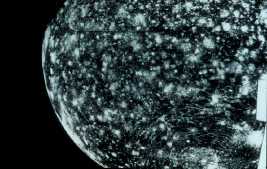
The surface of Callisto is deeply pockmarked with craters. It looks to be perhaps the most severely cratered body in the solar system. There are also very large craters to be found there. The severity
...more


